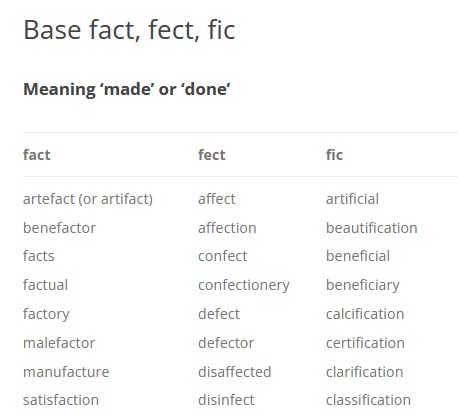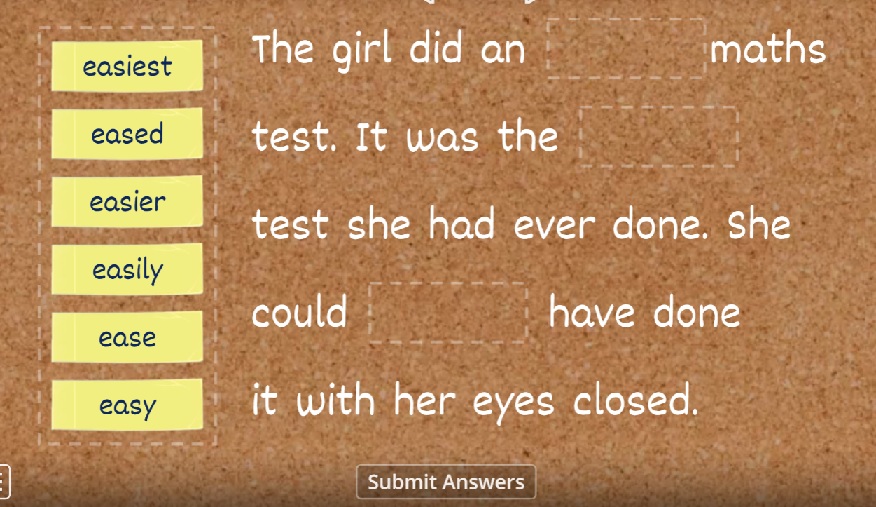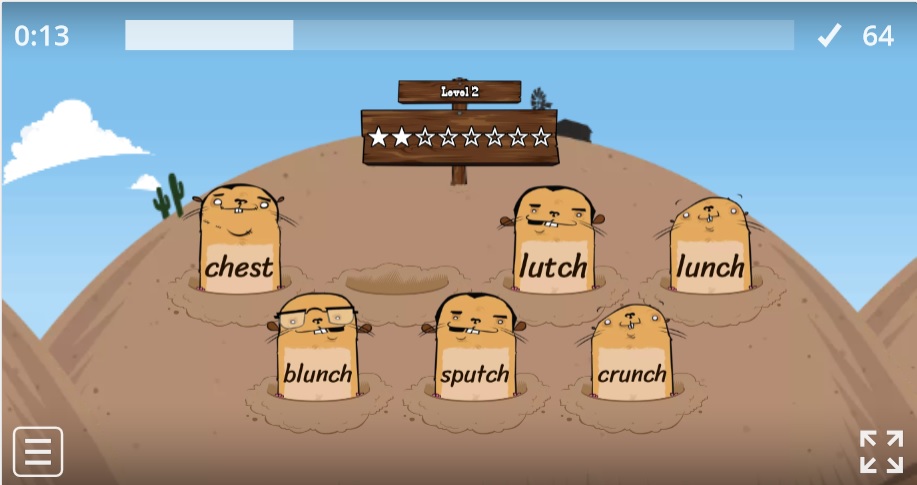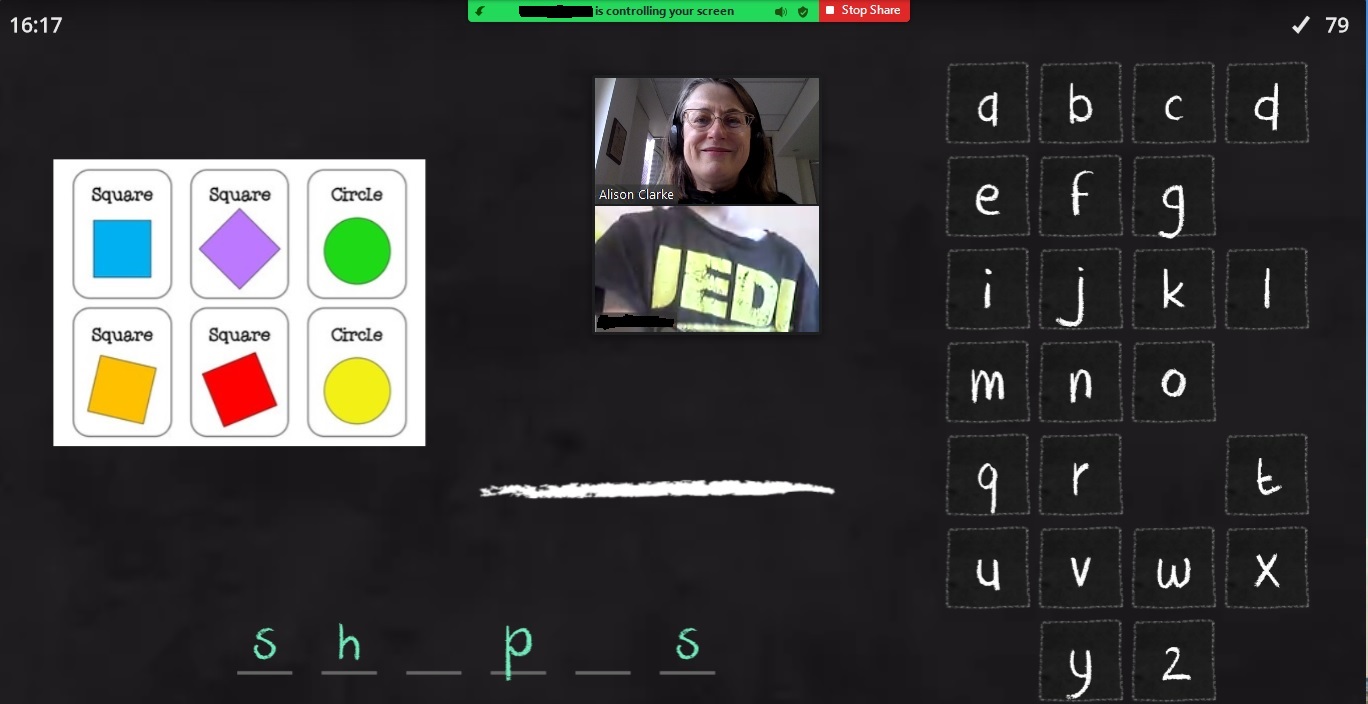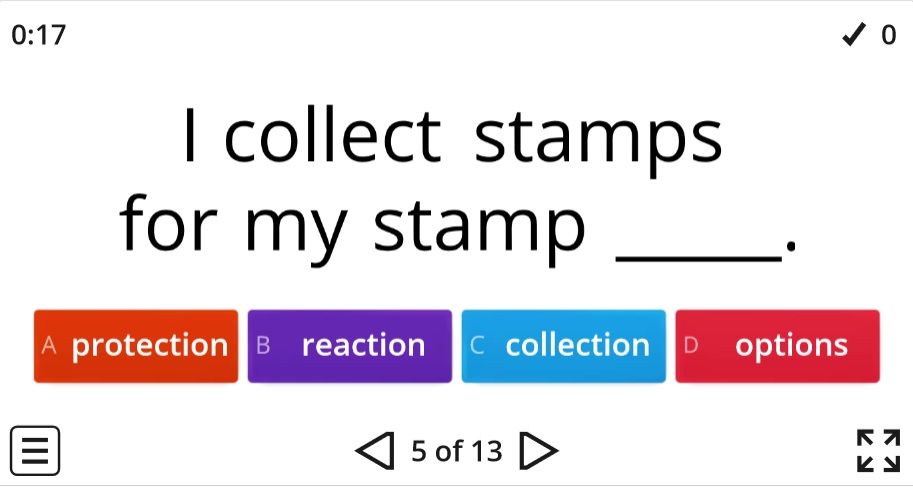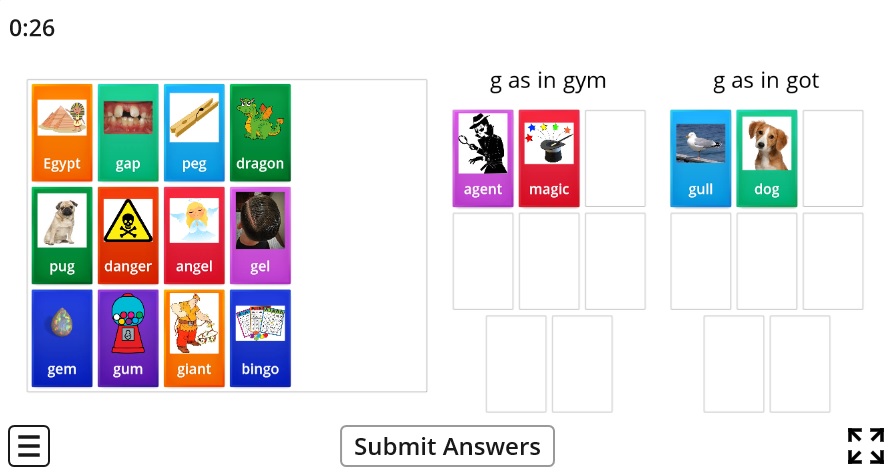New morpheme-based spelling lists
16 Replies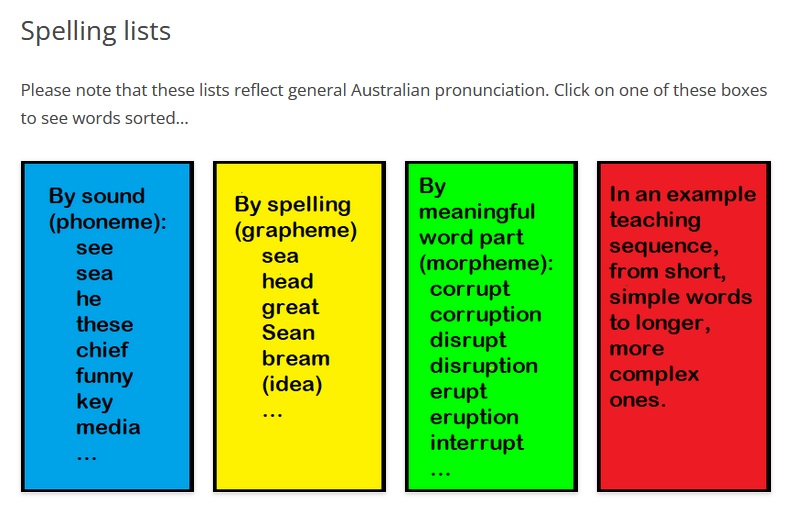
I’ve just added some morpheme-based word lists to the Spelfabet spelling lists.
Morphemes are meaningful word parts, and are listed in the following order: inflectional suffixes (part of grammar), prefixes, derivational suffixes, and bound bases from Germanic, Latin and Greek.
These lists have been harder to make than I’d expected, but also more interesting, because so many morphemes, er, morph.
For example, the ‘fact’ in factory has the same origin as the ‘fect’ in ‘confectionery’ and the ‘fic’ in ‘artificial’ and ‘fiction’. They’re all to do with making stuff, of course. I’ve therefore put them all on the same list, which starts like this:
Sometimes it’s hard to know how to classify morphemes, especially Greek ones. The Greek base ‘logue/log’, as in ‘catalogue’ and ‘analogous’, has the same origin as the -ology suffix in ‘biology’, ‘mythology’ and ‘psychology’, so I tried hard to keep them together, but in the end settled on two linked entries, here’s the bound base one:
If you’re using teaching resources like Word Sums or the Base Bank , you might notice that sometimes my lists have a single entry for a morphing morpheme (e.g. ‘vene’, ‘ven’ or ‘vent’ meaning ‘come’), whereas their resources have two entries. I don’t think this matters, and hope that those resources and my lists are complementary, since it’s easier to work with just one version of a morpheme (what linguists call an allomorph), but it can be interesting and useful to link other versions.
It will probably take a while for Google’s bots to crawl all over the new lists and make it possible to search for e.g. ‘spelfabet base logue’ and get the relevant list straight away. However, it’s been possible to Google e.g. ‘spelfabet igh as in night’ for years, so I’m hoping that soon the bots will do their work, and make it easy for teachers and others to find the morpheme-based spelling lists.
I’ll keep adding more morphing morphemes to the site as time permits, but wanted the lists made available before this week’s DSF Language, Literacy and Learning Virtual Conference, as I talk about morphology quite a bit in my session. Hope you’re looking forward to this conference as much as I am, and that you find my morpheme-based lists useful.
What helps kids read and spell multisyllable words?
19 RepliesVirus rules permitting, the Spelfabet team will present a workshop at the Perth Language, Learning and Literacy conference on 31st March to 2nd April this year.
The title is “Mouthfuls of sounds: Syllables sense and nonsense”, so I’m now scouring the internet for research on how best to help kids read and spell multi-syllable words.
Teaching one-syllable words well seems to be going mainstream
Lots of people seem to have now really nailed synthetic phonics, and are using and promoting it in the early years and intervention (yay!). It’s become so mainstream that I just bought three pretty good synthetic phonics workbooks (Hinkler Junior Explorers Phonics 1, 2 and 3) for $4 each at K-Mart (in among quite a lot of dross, but it’s a start).
Many synthetic phonics programs and resources focus mainly on one-syllable words, most of which only contain one unit of meaning (morpheme), apart from plurals like ‘cats’ (cat + suffix s), past tense verbs like ‘camped’ (camp + suffix ed), and words with ancient, rusted-on suffixes like grow-grown and wide-width.
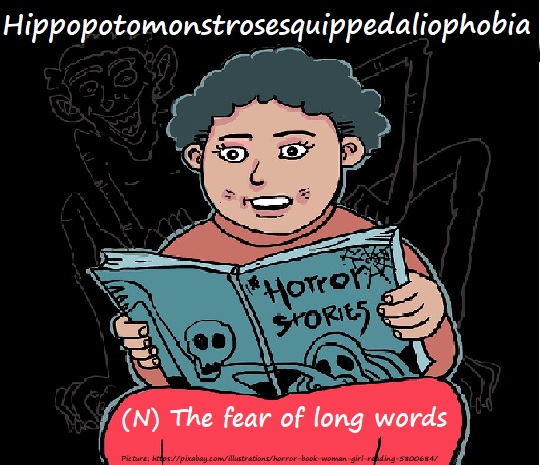
Multisyllable words contain extra complexity
Synthetic/linguistic phonics programs which target multisyllable words, including spelling-specific programs, vary widely in their instructional approach. Multisyllable words aren’t just longer (in sound terms, though words like ‘idea’ and ‘area’ are short in print), they contain extra complexity:
- Most contain unstressed vowels. When reading by sounding out, we apply the most likely pronunciation(s) to their spellings, often ending up with a ‘spelling pronunciation’ that sounds a bit like a robot, with all syllables stressed. We then need to use Set for Variability skills (the ability to correctly identify a mispronounced word) to adjust the pronunciation and stress the correct syllable(s).
This can mean trying out different stress patterns, and sometimes also considering word type – think of “Allow me to present (verb) you with a present (noun)”. Homographs often have last-syllable stress if they’re verbs, but first syllable stress if they’re nouns.
- Prefixes and suffixes change word meaning/type, they don’t just make words longer e.g. jump (simple verb), jumpy (adjective), jumped (past tense/participle), jumping (present participle), jumpier (comparative), jumpiest (superlative), jumpily (adverb), and the creature you get when you cross a sheep with a kangaroo, a wooly jumper (agent noun, ha ha). I write ‘wooly’ not ‘woolly’ (though both are correct), because it’s an adjective not an adverb: wool + adjectival ‘y’ suffix, as in ‘luck-lucky’ and ‘boss-bossy’, not wool + adverbial ‘ly’ suffix, as in ‘real-really’ and ‘foul-foully’.
- Word endings often need adjusting before adding suffixes: doubling final consonants (run-runner), dropping final e (like-liking) and swapping y and i (dry-driest). Kids need to learn when to adjust, and when not to, so they don’t over-adjust and end up with ‘open-openning’, ‘trace-tracable’, and ‘baby-babiish’.
- Co-articulation (how sounds shmoosh together in speech) often alters how morphemes are pronounced when they join – compare the pronunciation of ‘t’ in ‘act’ and ‘action’. Sometimes this also results in spelling changes e.g. the ‘in‘ prefix in ‘immature’, ‘imbalance’, ‘impossible’ (/p/, /b/ and /m/ are all lips-together sounds), ‘illegal’, ‘irrelevant’, ‘incompetent’ and ‘inglorious’. ‘In’ is pronounced ‘ing’ at the start of words beginning with back-of-the-mouth /k/ and /g/, like the ‘n’ in ‘pink’ and ‘bingo’.
- Reading longer words requires a lot more trying-out different sounds, particularly flexing between checked and free (or ‘short/long’) vowels, as in cabin-cable, ever-even, child-children, poster-roster, unfit-unit. Vowel sounds in base words often change when suffixes are added, e.g. volcano-volcanic, please-pleasant, ride-ridden, sole-solitude, study-student, south-southern (word nerds, look up Trisyllabic Laxing for more on this).
- Many word roots, like ‘dict’, ‘spect’, ‘fract’ and ‘path’, aren’t English words in their own right, but still mean something. However, teaching morpheme meanings may not have much benefit for decoding, fluency, or even vocabulary or comprehension (see Goodwin & Ahn (2013) meta-analysis of morphological interventions).
- Spellings that look like digraphs sometimes represent two different sounds in different syllables e.g. shepherd, pothole, area, stoic, away, koala (see this blog post), again requiring flexible thinking about how to break words up.
I use the Sounds-Write strategy to help kids read and spell multisyllable words, which doesn’t teach spelling rules, syllable types, or other unreliable, wordy things. The Phono-Graphix and Reading Simplified approaches are similar.
However, Sounds-Write doesn’t have an explicit focus on morphemes (well, maybe their new Yr3-6 course does, I haven’t done that yet), so I’ve also been using various morphology programs and resources: books by Marcia Henry, Morpheme Magic, games like Caesar Pleaser and Breakthrough To Success, Word Sums, the Base Bank, and the Spelfabet Workbook 2 v3 for very basic prefixes and suffixes. However, I need a better grip on the relevant research and its implications for practice.
Video discussion on syllable issues
There’s an interesting video of a discussion about research on syllable issues between Drs Mark Seidenberg, Molly Farry-Thorn and Devin Kearns (you might know his Phinder website) on Youtube, or click here for the podcast.
I always want to shout “Speak up, Molly!” when watching these discussions, because she doesn’t say much, but what she does say is usually great. Near the end of this video, she summarises the implications for teaching. Here’s my summary of her summary:
- Explicit teaching about syllable types takes time, adds to cognitive load and takes kids out of the process of reading, so try to keep it to a minimum in general instruction.
- Children who aren’t managing multisyllable words after general instruction may need to be explicitly taught vowel flexing, and/or about syllable types.
- Group words in ways that make the patterns/regularities and clear, and help children practise vowel flexing.
- It can be helpful for teachers to know a lot about syllables, rules etc, but that doesn’t mean it all needs to be taught.
Dr Kearns then goes further, saying he suggests NOT teaching syllable types and verbal rules, apart from basic things like ‘every syllable has a vowel’. Instead, he recommends demonstration of patterns and then lots of practice. Many children with literacy difficulties have language difficulties, so verbal rules can overwhelm/confuse them, and aren’t necessary when skills can be learnt via demonstration and practice.
I’m now trying to get my head around his research paper How Elementary-Age Children Read Polysyllabic Polymorphemic Words (PSPM words) without getting too overwhelmed/confused by terms like ‘Orthographic Levenshtein Distance Frequency’, ‘Laplace approximation implemented in the 1mer function’ and BOBYQA optimization’, and having to go and lie down.
The 202 children studied were in third and fourth grade, attending six demographically mixed schools in the US. This was quite a complex study with multiple factors and measures, so I won’t try to summarise the methods and results, but instead skip to what I think are the main things it suggests for teaching/intervention (but please read it yourself to be sure):
- Strong phonological awareness helps kids read long words, though it may make high-frequency words a little harder, and low-frequency words a little easier. It may help kids link similar sounds in bases and affixed forms, e.g. grade-gradual.
- Strong morphological awareness also helps kids read long words. It’s more helpful than syllable awareness. Processing a whole morpheme is more efficient than processing its component parts, and since morphemes carry meaning, they may help with vocabulary access.
- It helps to know sound-spelling relationships and how to try different pronunciations of spellings in unfamiliar words, especially vowels.
- Having a large vocabulary helps too, as children are more likely to find a word in their oral language system which matches (more or less, via Set for Variability) their spelling pronunciation. Children with large vocabularies might also persist longer in the search for a relevant word.
- High-frequency long words, and words with very common letter pairs (bigrams), are easier to read than low-frequency words and ones with less common letter pairs.
- Most kids learn to process morphemes implicitly in the process of learning to read long words, but struggling readers have more difficulty extracting information implicitly, so many need to be explicitly taught to do this. Strategic exposure and practice is more likely to produce implicit statistical learning than teaching rules, meanings etc.
- It’s easier to process base words that don’t change in affixed forms (e.g. appear-appearance) than ones that change a bit (e.g. chivalry-chivalrous). Kids with weak morphological awareness may need to be taught awareness of both.
- Knowing many derived words’ roots (e.g. the ‘dict’ in ‘contradict’, ‘predict’, ‘dictionary’, ‘dictate’, ‘addict’, ‘valedictory’, and ‘verdict’) makes it more likely the reader will be able to use root word information to read long words.
- Knowledge of orthographic rimes doesn’t seem to help kids read long words. Kearns calls these ‘phonograms’: the vowel letter and any consonant letters following it in a syllable e.g. the ‘e’ and ‘ict’ in ‘predict’, or the ‘uc’ and ‘ess’ in ‘success’.
- This study focussed on reading accuracy but not fluency, and didn’t measure prosodic sensitivity or Set for Variability skills. Further research is needed on these.
If you have insights on any of the above, please write them in the comments below.
New Phonics With Feeling books and author interview
3 Replies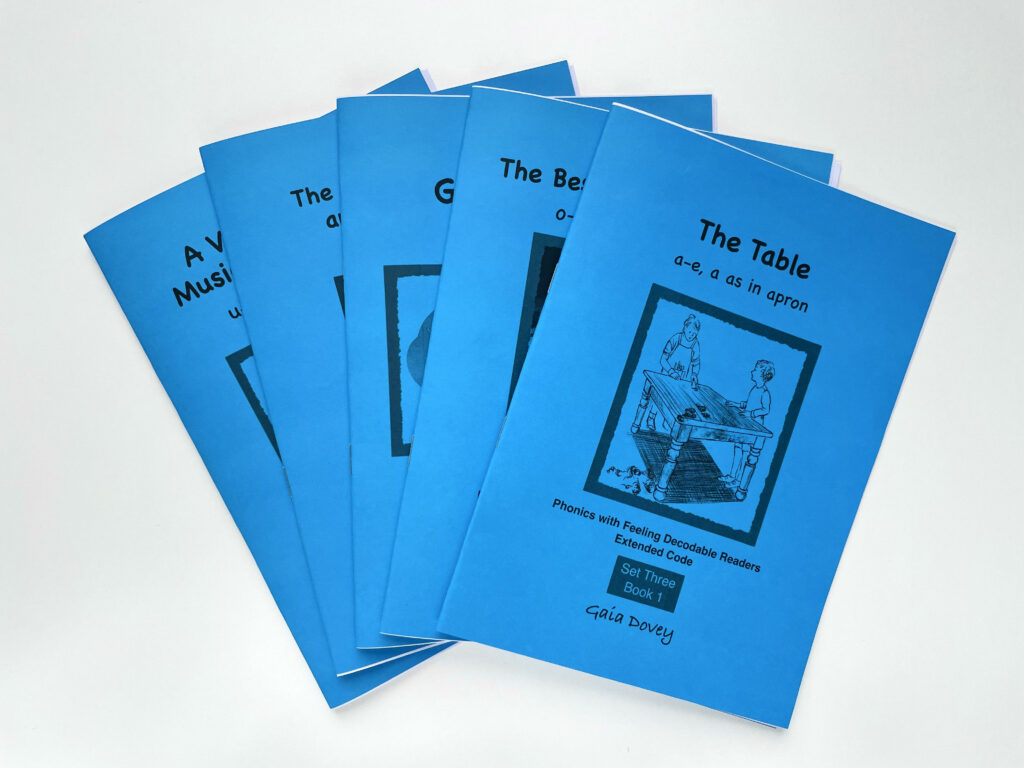
Set Three of the download-and-print Phonics With Feeling Extended Code readers are now available from the Spelfabet shop.
These books provide lots of reading practice of words with single-letter ‘long’ vowel sounds, as in ‘apron’, ‘being’, ‘final’, ‘open’ and ‘using’.
Many of these are suffixed forms of the ‘split vowel’/’silent final e’ spellings in Set Two e.g. make-making, Swede-Swedish, ice–icy, hope-hoped, cute-cutest. Word lists at the start of each book make this explicit.
The ‘c’ as in ‘ice’ and ‘g’ as in ‘age’ spellings, which often occur with these spellings, are practised in the Extended Code Set One books.
The Set Three books also include the ‘short’ vowel sounds, as in ‘at’, ‘red’, ‘in’, ‘on’ and ‘up’. When tackling new words, children should be encouraged to try both sounds for a vowel letter, if the first sound they try doesn’t produce a word that makes sense. This requires phoneme manipulation skills, and the knowledge that a spelling can represent more than one sound.
Like the other Phonics With Feeling books, the Set Three books have a print-5-copies version (parent/aide) for 40c per print, and a bulk print-30-copies version (teacher/clinician) for 20c per print. Our free quizzes (downloadable or on Wordwall) have been updated to include Set Three.
Teresa Dovey (pen name Gaia Dovey, as that’s what her grandkids call her) is the author of the Phonics With Feeling decodable readers. Here’s a 15-minute interview in which she discusses why she started writing the books, why they’re called Phonics With Feeling, her academic background in English Literature, what the books are like, who they’re for, how they can be used, and some of the feedback she’s received on them.
We hope these books make decodable text interesting and enjoyable for children, and affordable for adults, and that they help kids learn to decode as well as Teresa’s grandkids, so they can go on to enjoy reading whatever they choose.
If you’ve tried the books, please share any comments or feedback you have below.
Top 10 online PA/phonics resources/activities
23 Replies200+ days in COVID-19 lockdown and no clear end in sight, so I’m scratching around for fresh ways to target phonemic awareness, phonics and morphology online. Maybe you are too. Here are some things I was SO GRATEFUL to find. A million thanks to their creators. Please add your favourite resources and ideas in the comments.
- Wordwall
I think my head would have imploded in the last 18 months without a Wordwall subscription (AUD$12 a month for all the games). I’ve made lots of activities which you can use for free, and so have many others.
Only the crossword and hangman games require spelling rather than reading to play, but not to create. I therefore get kids to help me create a game online: first choose a game, type the target words/sentences into it, then play the game, then go on the leader board. Playing the game again can be part of the homework, either on a computer or as a printable crossword or word search.
2. Phonic Books Moon Dogs At Home books and other resources
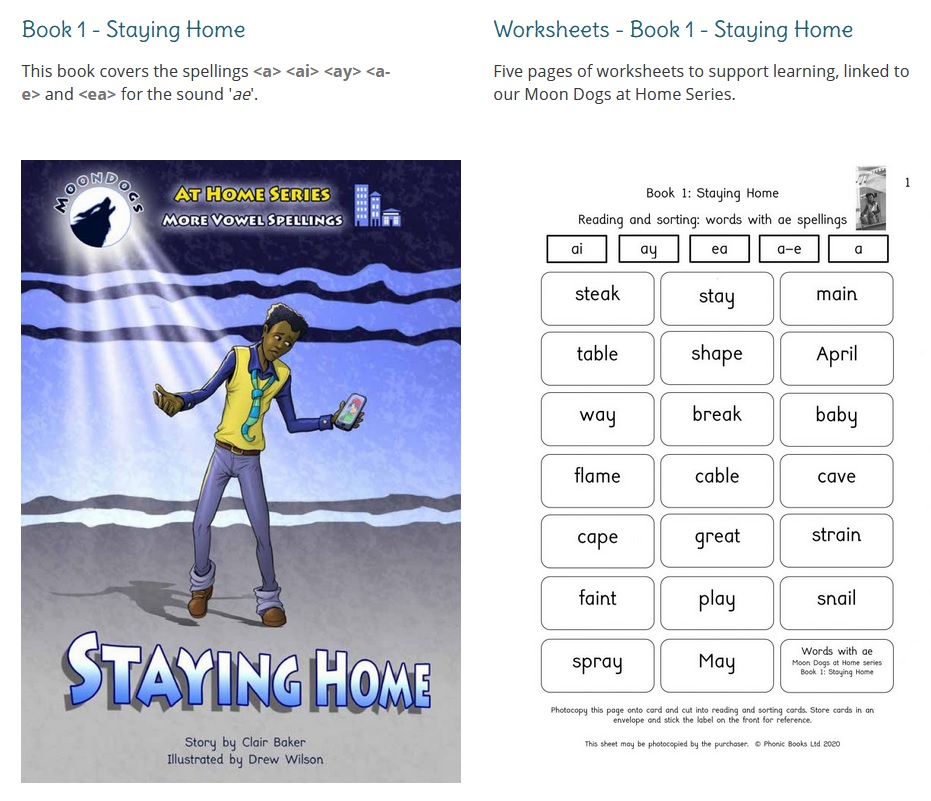
We use the physical Phonic Books resources a lot, and have found their free online resources very useful during our lockdowns. So generous, and so relevant. A lot of the WordWalls we’ve created also match their books’ teaching sequences.
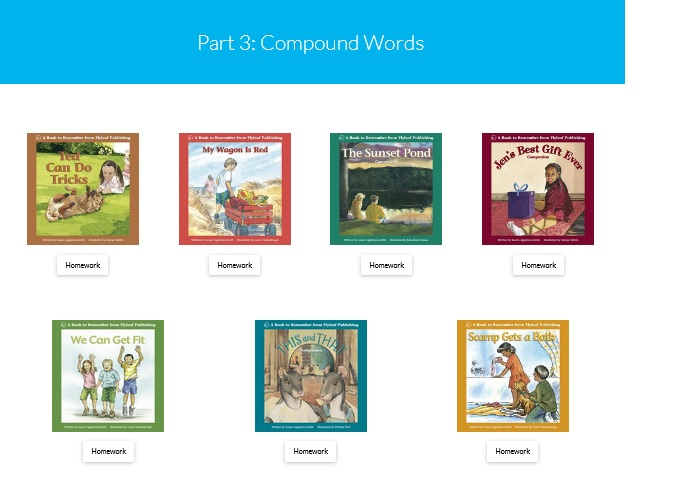
Flyleaf’s Online Portal contains lots of cute books from the UK which are perfect for online use, and all free at present, because of the pandemic. Again, so generous! Jen’s Best Gift Ever is my favourite, click here to read it, and here’s a comprehension quiz I’ve made as a follow-up activity (use it as a Gameshow Quiz for more pizazz).
4. ICT Games
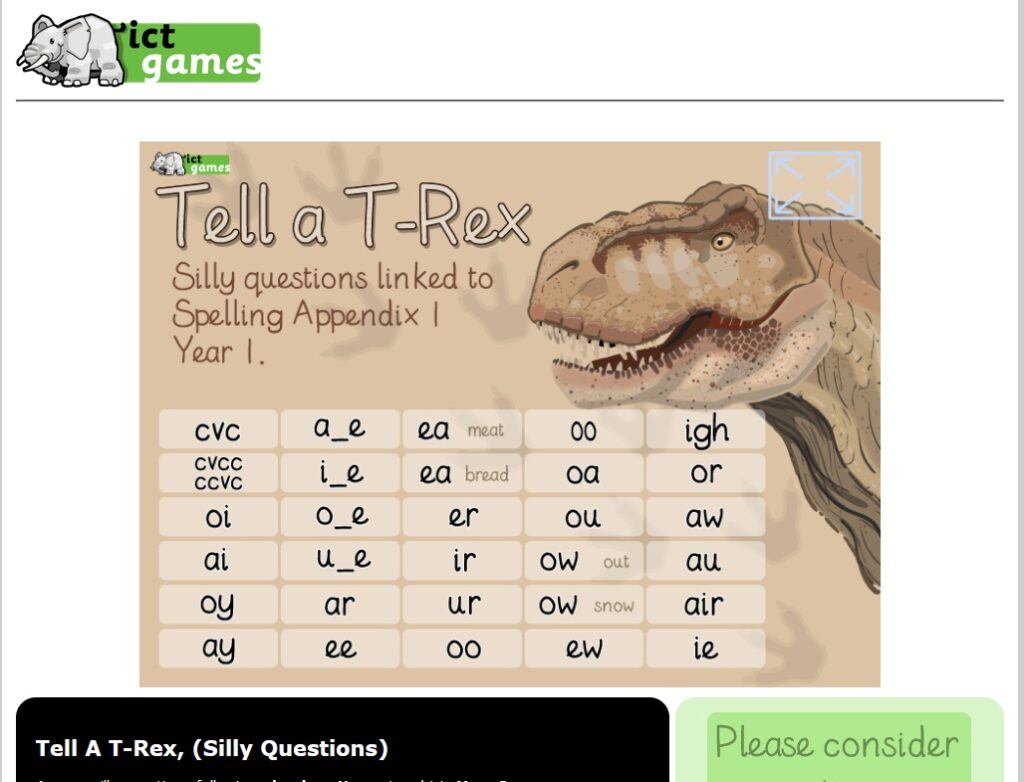
ICT games are all free online, and a quick, fun way to warm up or finish off a session. I often ask kids to type their own lists into Help A Hedgehog, then see how many they can read before the 90 second timer runs out. Other favourites are Tell A T-Rex, Poop Deck Pirates, Viking Full Circle, Forest Phonics, and Phonics Finder. This site runs on a donation model because the husband-and-wife team behind it think no child should be prevented from learning by lack of money. So if you can afford to donate, please do.
5. Sounds Write interactive whiteboard activities

If you’re using the program Sounds-Write, this USB contains heaps of activities ready for use online. They cover the Initial Code (one-letter=one-sound spellings plus major consonant digraphs) plus vowel spellings up to Sounds-Write Unit 28. The USB costs AUD$95, and I’ve definitely gotten my money’s worth.
Because many other Sounds-Write activities are provided as pdfs as part of the training, they have also lent themselves to online use (see item 8 below), and the Aussie/NZ Sounds-Write community has lots of great ideas and resources.
6. Little Learners Love Literacy apps and other resources
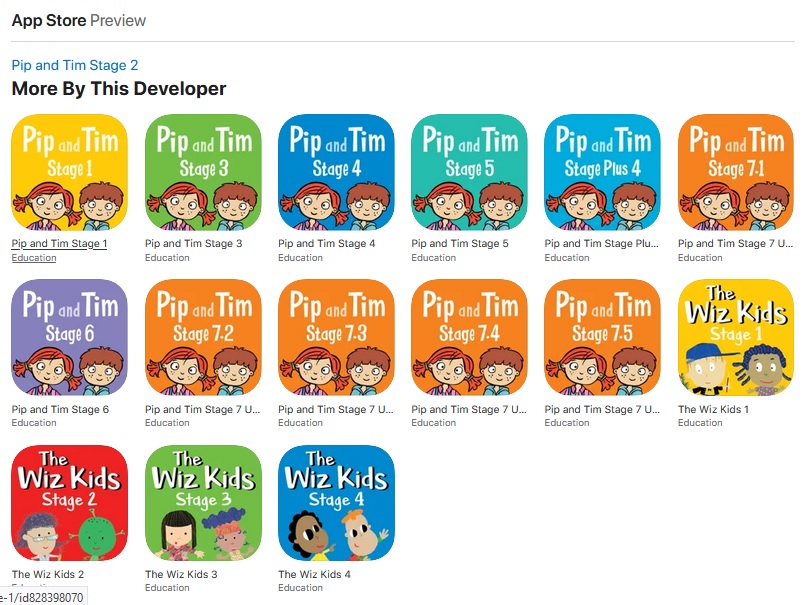
The app versions of the lovely LLLL books have been a great way to show young clients the books, by sharing the iPad screen online. Always affordable, the iPad versions are currently free till the end of September (at least in the Australian store). Which is so incredibly generous, and will help so many young, locked-down children learn to read. Lots of paper-based LLLL activities also lend themselves to online use, see item 8 below.
7. Powerpoint versions of decodable texts
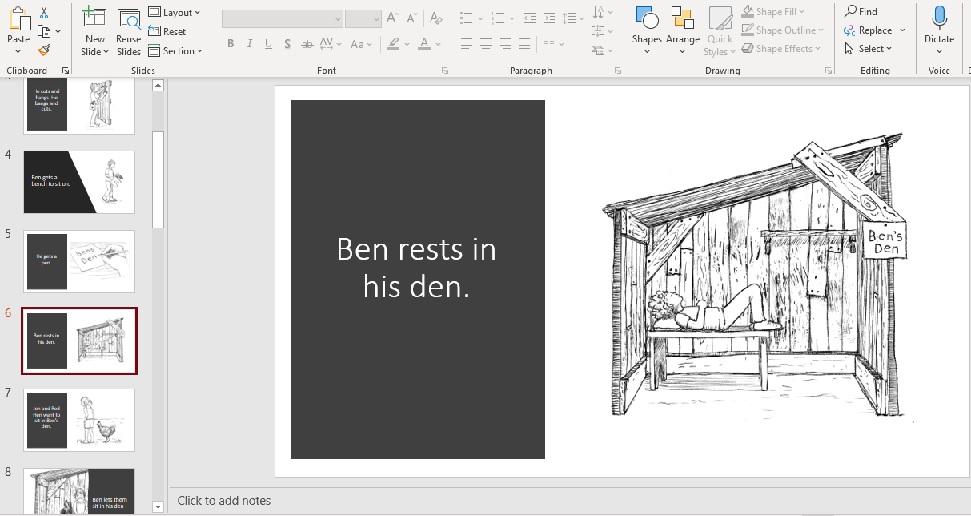
Some kids with good keyboarding skills like typing a simple story to dictation, to create a book they can then show a parent or teacher. I’ve used some Phonics With Feeling books for this, with author permission. I take screenshots of the pictures and paste them onto slides, type the text, then use Powerpoint’s formatting suggestions to make it look more schmick. Then I save it, delete the text and save it again under a different file name. Voila! A simple onscreen reading then spelling activity with large text.
8. Adobe Acrobat Reader editing tools
We use Zoom and it has been excellent, but I rarely use their whiteboard or editing tools. The free Adobe Acrobat editing tools work much better with pdfs. You can scroll through homework and cover it in ticks. You or the learner can type, change the font size and colour, and move text around. You can underline or put boxes around target words in sound searches (we play a guess-how-many-jellybeans-in-the-jar game with these, first guessing how many words with the target sound there will be). I just wish I could turn off the predictive text! (any ideas? I’ve tried everything!)

You can also play games (like the one above from Nicole Brady) using big dots as counters. Sounds-Write, Phonic Books and Little Learners Love Literacy books all have paper-based games that can be scanned as pdfs and used this way, and there are digital versions of the LLLL books. I use the iPad or iPhone app Make Dice held up to the camera for dice games, as I’m rubbish at online dice (all tips gratefully received). Make Dice can also replace the spinner for the Phonic Books Spin, Read and Spell games.
9. Kahoot!

I’m sad to say that I’ve only recently figured out that Kahoot! can motivate many kids to do quite a lot of reading. The best music teacher in the world (hi Roz!) told me it had revolutionised her lessons. Kids are often familiar with it from school, and think it’s fun and cool. We’re writing some downloadable quizzes now which should be easy to turn into Kahoot!s.
10. Jamboard
Google’s Jamboard is another useful tool I wish I’d discovered earlier. It’s like an online whiteboard with colourful post-it notes, from which I’ve made simplified versions of my moveable alphabet for word-building sequences, e.g. here the learner would be asked to change “stitch” into “switch”:
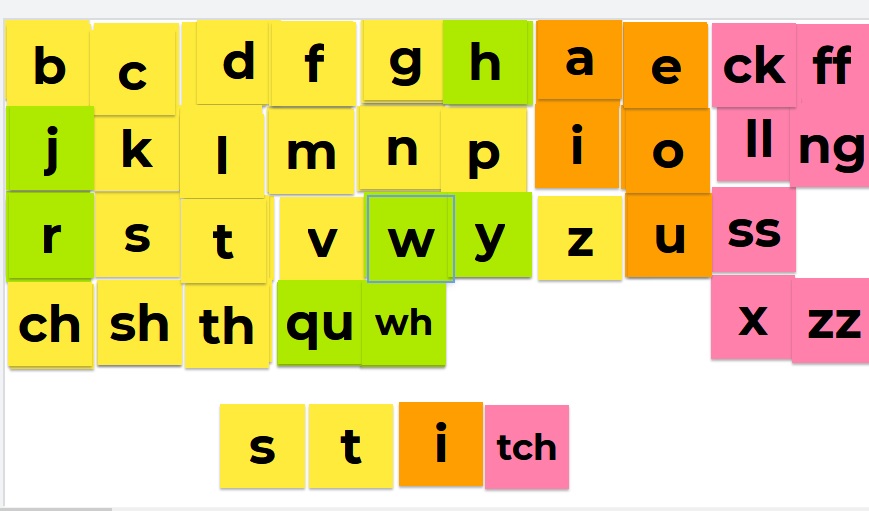
Kids tend not to stretch or rotate the tiles the way they have in other formats I’ve tried using for this activity. Jamboard is also a quick way to create neat word sorting activities:
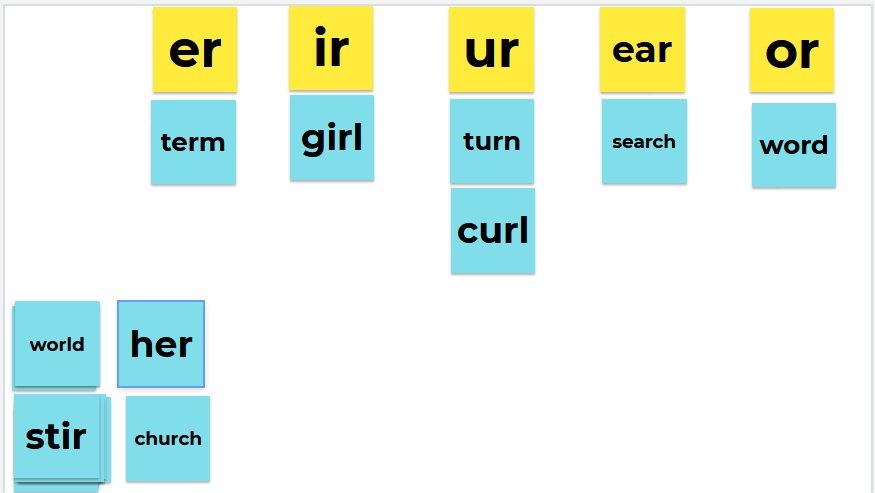
I get words for these sorts from my website’s sorted-by-sound lists (for same-sound-different-spellings activities) or sorted-by-spelling lists (for same-spelling-different sounds activities).
I hope you found some useful information in all that, especially if you’re still working online too. Pretty please leave any great ideas you have to share in the comments.
New Spelfabet workbooks and EOFY discount
24 Replies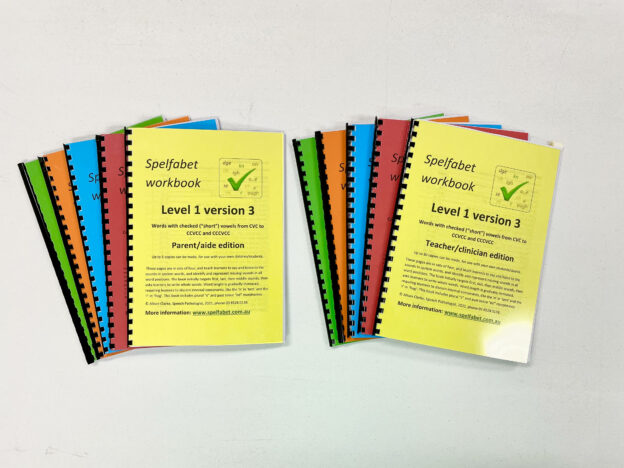
I’ve finally finished five new download-and-print Spelfabet workbooks. These version 3 books better align with the Sounds-Write program and the Phonic Books myself and my colleagues are now often using, and with the Drop In Series books for older learners.
For a 20% discount on these and anything else in the Spelfabet shop, type the coupon code “EOFY 2021” at the checkout.
Many of our clients have memory, attention, language or other difficulties as well as learning difficulties, and struggle to make the transition from Sounds-Write’s Initial Code to the Extended Code, which requires them to learn several spellings of a new vowel sound at once.
We only see our clients weekly or fortnightly, so need lots of activities that are easy for parents to supervise at home. I thus wanted new workbooks to teach vowel spellings more gradually, with earlier, explicit teaching about morphemes and work on polysyllabic words, and reviewing prior learning in lots of sentence-writing with punctuation (having read The Writing Revolution).
I’ll be talking about meeting the needs of clients like these at the free online Sounds-Write 1:1 Symposium on May 23-28. The lineup is amazing, it’s hard to know where to start, don’t miss it!
I’ve made videos about each new workbook, in which I hope you enjoy my fire-engine red fingernails (covering ugly nail bruise from dropping a chookhouse paving stone on my finger, yeow). There are also detailed descriptions of each book in the website shop, but essentially their contents are:
Level 1: Words with checked (‘short’) vowels from CVC to CCVCC and CCCVCC (C=consonant, V=Vowel)
Level 2: Consonant digraphs, basic suffixes, and up to three-syllable words with varied stress
Level 3: “Long/short” vowel contrasts, “soft” c and g, extra suffixes and some prefixes
Level 4: Seven extra vowel sounds, four extra vowel spellings, and more practice of patterns introduced in earlier books.
Level 5: 14 extra vowel spellings and more practice of previous patterns.
Like the previous workbooks, Version 3 has a parent/aide edition and a slightly more expensive teacher/clinician edition, the only difference being that you can print more copies of the teacher/clinician file. File pictures are in colour, but you don’t have to colour print them. Most of the pictures in the workbooks are PCS, a trademark of Tobii-Dynavox LLC, all rights reserved, used with permission.
The old Version 2 workbooks and kits are still in my website shop in the “old versions” folder, if you still want one, or haven’t finished downloading ones you’ve bought. Sorry that I’ve only been able to finish half the workbooks for Version 3, I’m working on more now, but life is busy!
Hope you and yours are all staying virus-free (I’ve had my first vaccine), and I’d love to hear your thoughts on the new workbooks.
When digraphs ain’t digraphs
10 Replies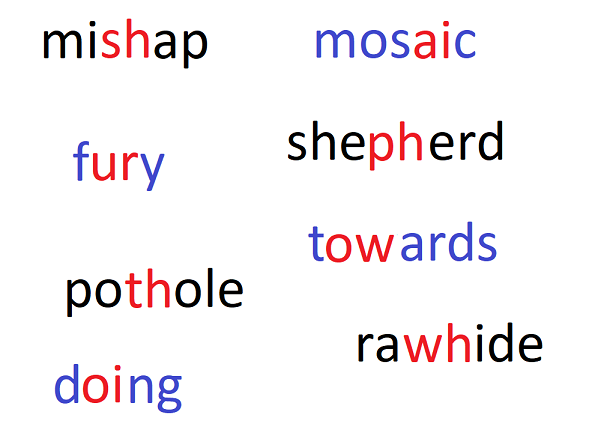
When working on decoding and spelling two-syllable words with a student, I often use the TRUGS deck 4 cards, which include the word “mishap”.
Invariably, my students parse this as “mish-ap”, rhyming the first syllable with “fish”.
At first this made me want to get out my correction tape and replace “mishap” with a word that would give them more immediate syllable-parsing success.
Then I realised “mishap” provides a perfect opportunity to discuss how spellings that look like digraphs aren’t always digraphs, so we also need to think about what word parts mean and how letters might work separately when tackling unfamiliar words. (more…)
New and improved phonics playing cards
5 Replies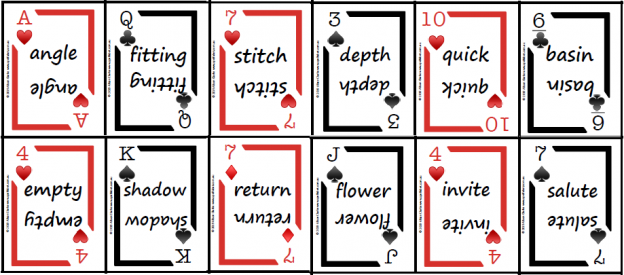
There’s a new set of downloadable phonics playing cards in the Spelfabet shop, including a couple of free decks. These add a few new sound-spelling relationships and syllable types as well as mixing and reviewing patterns covered earlier. Spaced practice, people.
The sequence broadly matches the Phonic Books (last bit of Magic Belt/That Dog, and most of Alba/Totem) and Sounds-Write teaching sequence, but the cards should be able to be used with most other phonics teaching sequences. All four of us at Spelfabet have done some work on these, after Caitlin Stephenson had the original idea.
Use these cards to play any of the games shown in videos in this previous blog post, or any other game you like requiring a standard deck of playing cards. (more…)

